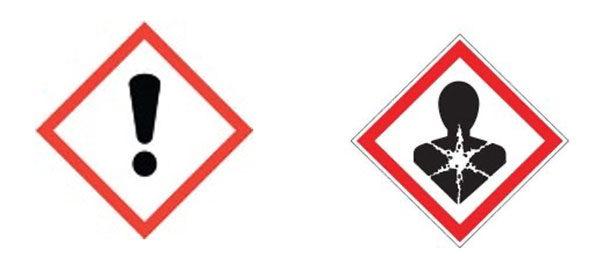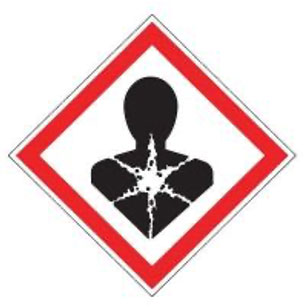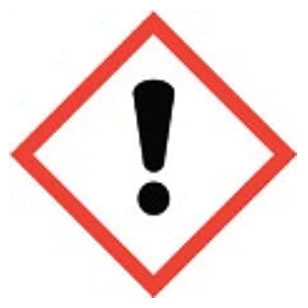SECTION 1: IDENTIFICATION
1.1 PRODUCT IDENTIFIER
Product Name: Walnut Shell – INCI – Juglans Regia
1.2 DETAILS OF THE SUPPLIER OF THE SAFETY DATA SHEET
| Name/Address: | Eco-Shell, LP 5230 Grange Rd. Corning CA 96021 USA |
| Telephone Number: | 530-824-8794 |
| Email: | info@ecoshell.com |
| Website: | www.ecoshell.com |
SECTION 2: HAZARD(S) IDENTIFICATION
2.1 CLASSIFICATION OF THE CHEMICAL
Hazard class: Walnut shells are not a chemical and have not been chemically processed.
| HAZARD CLASSIFICATION | CATEGORY |
| Hazard Note: Walnut Shell may cause skin or eye irritation Walnut Shell may contain trace amounts of walnut proteins that have been known to cause allergic reaction. |
2.2 LABEL ELEMENTS
Hazard pictogram:

Signal word: Irritant and Respiratory Sensitizers
Hazard statement: Walnut Shell may cause skin or eye irritation. Walnut shells may contain nut allergens.
Prevention: Observe good industrial hygiene practices.
Response: Wash hands thoroughly after handling.
Storage: Store in a well-ventilated place. Keep container tightly closed.
Disposal: Dispose of contents and container in accordance with all local, regional, national and international regulations.
2.3 ADDITIONAL INFORMATION
Main symptoms: Direct contact with eyes may cause temporary irritation. Walnut Shell may contain trace amounts of walnut proteins that have been known to cause allergic reaction.
Hazards not otherwise specified: None Known
0 % of the mixture consists of ingredient(s) of unknown acute toxicity
SECTION 3: COMPOSITION/INFORMATION ON INGREDIENTS
3.1 Hazard Identification Comments: Eco-Shell Walnut Shells are naturally occurring and have not been chemically processed.
| Material | CAS No. | Weight %* |
| Natural processed walnut shell | n/a | 100% |
SECTION 4: FIRST-AID MEASURES
4.1 DESCRIPTION OF THE FIRST AID MEASURES
| General information: | Ensure that medical personnel are aware of the materials(s) involved, and take precautions to protect themselves. |
| Inhalation: | Move to fresh air. Call a physician if symptoms develop or persist. |
| Skin contact: | Wash skin with plenty of soap and water. Get medical attention is irritation develops and persists. |
| Eye contact: | Rinse eyes with water. Get medical attention if irritation develops and persists. |
| Ingestion: | Rinse mouth. Get medical attention if symptoms occur. |
4.2 MOST IMPORTANT SYMPTOMS AND EFFECTS, BOTH ACUTE AND DELAYED
Direct contact with eyes or skin may cause temporary irritation.
Walnut Shell may contain trace amounts of walnut proteins that have been known to cause allergic reaction.
4.3 INDICATION OF ANY IMMEDIATE MEDICAL ATTENTION AND SPECIAL TREATMENTS NEEDED Note to physicians: Treat symptomatically.
Specific treatments: In case of accident or if you feel unwell, seek medical advice (show the label or SDS where possible).
SECTION 5: FIRE-FIGHTING MEASURES
5.1 EXTINGUISHING MEDIA
General hazards: If improperly handled, stored and/or exposed to and ignition source, this material may burn. High concentrations of dust in air can explode if sufficient temperature and ignition source occurs. Proper grounding of equipment is necessary to eliminate static electricity. No unusual fire or explosion hazard.
Suitable extinguishing media: Water, Fog, Foam, Dry chemical powder. Carbon dioxide (CO2) Unsuitable extinguishing media: None.
5.2 SPECIAL HAZARDS ARISING FROM THE SUBSTANCE OR MIXTURE
Specific hazards: None
Products of combustion: May include, and are not limited to: oxides of carbon.
5.3 Special protective equipment and precautions for fire-fighters (PPE)
Special protective equipment for fire-fighters: Self-contained breathing apparatus and full protective clothing must be worn in case of fire.
Special fire-fighting procedures: Keep upwind of fire. Move containers from fire area if you can do it without risk.
SECTION 6: ACCIDENTAL RELEASE MEASURES
6.1 PERSONAL PRECAUTIONS, PROTECTIVE EQUIPMENT AND EMERGENCY PROCEDURES
For personal protection, see Section 8 of this SDS.
6.2 METHODS AND MATERIALS FOR CONTAINMENT AND CLEANING – UP
| Methods for containment: | Sweep, Shovel up, or Vacuum. Use appropriate Personal Protective Equipment (PPE). |
| Methods for cleaning-up: | Stop the flow of material, if this is without risk. Dike far ahead of spill for later disposal. Sweep, Shovel up, or Vacuum. Following product recovery, flush area with water. For waste disposal, see Section 13 of the SDS. |
| Large spills: | Stop the flow of material, if this is without risk. Dike the spilled material, where this is possible. Sweep, Shovel up, or Vacuum. and place into containers. Following product recovery, flush area with water. |
| Small spills: | Sweep, Shovel up, or Vacuum. Clean surface thoroughly to remove residual contamination. Never return spills to original containers for re-use. |
| Environmental precautions: | Avoid discharge into drains, water courses or onto the ground. |
SECTION 7: HANDLING AND STORAGE
7.1 PRECAUTIONS FOR SAFE HANDLING
Precautions for Safe handling: Observe good industrial hygiene practices.
General hygiene advice: Ensure that medical personnel are aware of the materials(s) involved, and take precautions to protect themselves.
7.2 CONDITIONS FOR SAFE STORAGE, INCLUDING ANY INCOMPATIBILITIES
| Safe storage: | Store away from incompatible materials. |
| Technical measures: | No specific recommendations. |
| Incompatible materials: | None known. |
| Safe packaging material: | No specific recommendations. |
| Precautions: | Use personal protective recommended in Section 8 of the SDS. |
| Safe handling advice: | Observe good industrial hygiene practices. |
| Suitable storage conditions: | Store away from incompatible materials. |
| Handling-technical measures: | No specific recommendations. |
| Local and general ventilation: | Provide adequate ventilation. |
SECTION 8: EXPOSURE CONTROLS/PERSONAL PROTECTION
8.1 CONTROL PARAMETERS
Control parameters: Follow standard monitoring procedures.
8.2 EXPOSURE CONTROLS
Engineering measures to reduce exposure:
Good general ventilation (typically 10 air changes per hour) should be used. Ventilation rates should be matched to conditions. If applicable, use process enclosures, local exhaust ventilation, or other engineering controls to maintain airborne levels below recommended exposure limits. If exposure limits have not been established, maintain airborne levels to an acceptable level.
8.3 INDIVIDUAL PROTECTIVE MEASURES
| General: | Use personal protective equipment as required. |
| Eye protection: | If contact is likely, safety glasses with side shields are recommended. |
| Hand protection: | For prolonged or repeated skin contact, use suitable protective gloves. |
| Respiratory protection: | In case of insufficient ventilation, wear suitable respiratory equipment. |
| Skin and body protection: | Wear suitable protective clothing. |
| Hygiene measures: | Always observe good personal hygiene measures, such as washing after handling the material and before eating, drinking, and/or smoking. Routinely wash work clothing and protective equipment to remove contaminants. |
| Thermal hazards: | Wear appropriate thermal protective clothing, when necessary. |
| Environmental exposure controls: | Environmental manager must be informed of all major releases. |
SECTION 9: PHYSICAL AND CHEMICAL PROPERTIES
9.1 INFORMATION ON BASIC PHYSICAL AND CHEMICAL PROPERTIES
| Appearance: | Light brown granules |
| Color: | Light brown |
| Form: | granules |
| Odor: | No odor |
| Odor Threshold: | Not available |
| pH (at 25⁰C in water): | 4-6 |
| Melting Point/Freezing Point: | Not available |
| Initial Boiling Point and Boiling Range: | Not available |
| Flash Point: | 380⁰F/193⁰C |
| Evaporation Rate: | Not available |
| Flammability (solid, gaseous): | Not Flammable |
| Lower Flammability/Explosive Limit: | Not available |
| Upper Flammability/Explosive Limit: | 470⁰F/243⁰C |
| Auto-ignition Temperature: | Not available |
| Decomposition Temperature: | Not available |
| Oxidizing Properties: | Not available |
| Explosive Properties: | Not available |
| Vapor Pressure (mm Hg@38⁰C): | Not available |
| Vapor Density: | Not available |
| Density (lb/gal): | Not available |
| Relative Density/Specific Gravity: | 1.2 |
| Solubility in water/miscibility: | Not water soluble |
| Partition coefficient: n-octanol/water: | Not available |
| Free Moisture (80ºC FOR 15HRS): | 3-9% |
| Hardness – Vickers No.: | 25-30 |
| MOHS SCALE: | 3-4 |
| Elastic Modulus (MOE): | 22,900 (9/7/06 test) |
| Dry Packing Density (LBS PER CU. FT.): | 30-50 |
| Other information: | Not available |
| Incompatibilities: | None known. |
SECTION 10: STABILITY AND REACTIVITY
10.1 REACTIVITY The product is stable and non-reactive under normal conditions of use, storage and transport.
10.2 CHEMICAL STABILITY
Chemical stability: Material is stable under normal conditions.
Materials to avoid: The product is stable and non-reactive under normal conditions of use, storage and transport.
10.3 POSSIBILITY OF HAZARDOUS REACTIONS
Hazardous reactions: No dangerous reaction known under conditions of normal use.
10.4 CONDITIONS TO AVOID Contact with incompatible materials.
10.5 INCOMPATIBLE MATERIALS None known.
10.6 HAZARDOUS DECOMPOSITION PRODUCTS
Hazardous decomposition products: No hazardous decomposition products are known.
Hazardous polymerization: Does not occur.
Other information: Not available.
SECTION 11: TOXICOLOGICAL INFORMATION
11.1 INFORMATION ON TOXICOLOGICAL EFFECTS
| Acute toxicity: | Walnut Shell may contain trace amounts of walnut proteins that have been known to cause allergic reaction. |
| Likely routes of exposure: | Skin contact. Eye contact. |
| Eye: | Direct contact with eyes may cause temporary irritation. |
| Skin: | No adverse effects due to skin contact are expected. |
| Ingestion: | Not an expected route of exposure. Expected to be a low ingestion hazard. |
| Inhalation: | Not an expected route of exposure. No adverse effects due to inhalation are expected. |
Calculated overall chemical acute toxicity values for this formulation:
| Calculated overall Chemical Acute Toxicity Values | ||
| LC50 (inhalation) | LD50 (oral) | LD50 (dermal) |
| >5 mg/kg (dust and mist) | >2000 mg/kg | >2000 mg/kg |
11.2 DELAYED, IMMEDIATE, AND CHRONIC EFFECTS OF SHORT- AND LONG-TERM EXPOSURE
| Skin corrosion/irritation: | Based on available data, this product is not expected to cause skin corrosion or irritation. Prolonged skin contact may cause dryness, redness, or cracking. |
| Serious eye damage/irritation: | Based on available data, this product is not expected to cause serious eye damage or irritation. Direct contact with eyes may cause temporary irritation. |
| Respiratory sensitization: | Walnut Shell may contain trace amounts of walnut proteins that have been known to cause allergic reaction. |
| Skin sensitization: | Walnut Shell may contain trace amounts of walnut proteins that have been known to cause allergic reaction. |
| Symptoms and target organs: | Walnut Shell may contain trace amounts of walnut proteins that have been known to cause allergic reaction. |
| Chronic health effects: | No chronic health effects known. |
| Carcinogenicity: | This product is not classified as a carcinogen. |
| Mutagenicity: | No data available to indicate product or any components present at greater than 0.1% are mutagenic or genotoxic. |
| Reproductive Toxicity: | This product is not expected to cause reproductive or developmental effects. |
Specific Target Organ Toxicity (STOT):
Single Exposure: Not classified as an STOT – Single Exposure.
Repeated Exposure: Not classified as an STOT – Repeated Exposure.
| Aspiration Toxicity: | Based on available data, this product is not expected to cause aspiration toxicity. |
| Other Information: | Not available. |
SECTION 12: ECOLOGICAL INFORMATION
12.1 ECOTOXICITY
| Ecotoxicity : | The product is not classified as environmentally hazardous. However, this does not exclude the possibility that large or frequent spills can have a harmful or damaging effect on the environment. |
| Acute aquatic toxicity: | The product is not classified as acutely environmentally hazardous. However, this does not exclude the possibility that large or frequent spills can have a harmful or damaging effect on the environment. |
| Chronic toxicity: | The product is not classified as having a chronic environmental hazard. However, this does not exclude the possibility that large or frequent spills can have a harmful or damaging effect on the environment. |
| Environmental effects: | The product is not classified as environmentally hazardous. However, this does not exclude the possibility that large or frequent spills can have a harmful or damaging effect on the environment. |
12.2 PERSISTENCE AND DEGRADABILITY
Persistence/biodegradability: Very slow if exposed to moisture and other organic materials. No known acute toxicity in water, waste water, or soil.
12.3 BIOACCUMULATIVE POTENTIAL
| Bioaccumulation: | No data available. |
12.4 MOBILITY
| Mobility: | No data available. |
| Mobility in soil: | No data available. |
| Mobility in non-soil: | No data available. |
12.5 OTHER ADVERSE EFFECTS
| Ozone layer: | No data available. |
SECTION 13: DISPOSAL CONSIDERATIONS
13.1 WASTE TREATMENT METHODS
| Disposal method: | This material must be disposed of in accordance with all local, state, provincial, and federal regulations. No special requirements. |
| Contaminated packaging: | Since emptied containers may retain product residue, follow label warnings even after container is emptied. Dispose of contents and container in accordance with all local, regional, national and international regulations. |
| EU codes: | The Waste code should be assigned in discussion between the user, the producer and the waste disposal company. |
| Residual waste: | Dispose of in accordance with local regulations. Empty containers or liners may retain some product residues. This material and its container must be disposed of in a safe manner (see: Disposal instructions). |
| Disposal instructions: | Collect and reclaim or dispose in sealed containers at licensed waste disposal site. Dispose of contents and container in accordance with all local, regional, national and international regulations. |
| Waste codes: | The Waste code should be assigned in discussion between the user, the producer and the waste disposal company. |
| Other disposal recommendations: | None |
SECTION 14: TRANSPORT INFORMATION
DOT Non-Bulk
Not classified as Dangerous Goods for Transport
DOT Bulk
Not classified as Dangerous Goods for Transport
IMDG
Not classified as Dangerous Goods for Transport
ICAO/IATA
Not classified as Dangerous Goods for Transport
Reportable quantity: Package sizes shipped in quantities less than the product reportable quantity are not subject to the RQ (reportable quantity) transportation requirements.
SECTION 15: REGULATORY INFORMATION
15.1 SAFETY, HEALTH AND ENVIRONMENTAL REGULATIONS/ LEGISLATIONS SPECIFIC FOR THE CHEMICAL
US Federal Regulations:
U.S. OSHA (Occupational Safety and Health Administration) Specifically Regulated Substances (29 CFR 1910.1001-1050)
No components of this product are present at concentration greater than or equal to 0.1% and identified as a carcinogen or potential carcinogen by OSHA.
SARA/CERCLA reporting requirements:
No components of this product are found at concentrations greater than or equal to 0.1% and are subject to the SARA/CERCLA reporting requirements.
State Right-to-Know Regulations
No components of this product are found at concentrations greater than or equal to 0.1% and are subject to state Right-to-Know reporting requirements.
EU – REACH Status:
A registration number is not available for Walnut Shell and are exempted from registration.
CANADA – WHMIS (Workplace Hazardous Materials Information System) Classification:
Not a controlled product under Canada WHMIS (Workplace Hazardous Materials Information System) classification scheme.
MEXICO:
Hazard Classification: 1-1-0
Carcinogen Status: No data available.
SECTION 16: OTHER INFORMATION
HMIS (Hazardous Materials Identification System) rating:
| Health: | 1 |
| Flammability: | 1 |
| Physical: | 0 |

NFPA 704 (National Fire Protection Association) rating:
| Health | 1 |
| Fire | 1 |
| Reactivity | 0 |

| Date of preparation: | June 16, 2021 |
| Version: | 1.0 |
| Revision Date: | June 16, 2021 |
| Disclaimer: | We believe the statements, technical information and recommendations contained herein are reliable, but they are given without warranty or guarantee of any kind. The information contained in this document applies to this specific material as supplied. It may not be valid for this material if it is used in combination with any other materials. It is the user’s responsibility to satisfy oneself as to the suitability and completeness of this information for the user’s own particular use. |